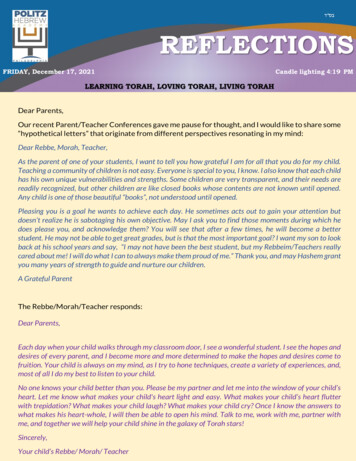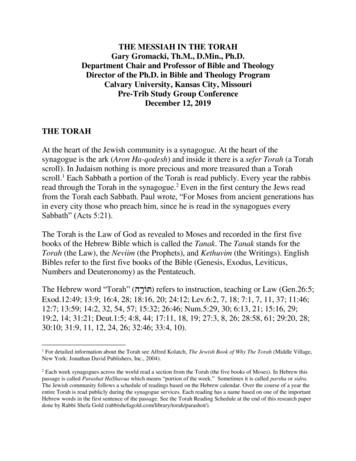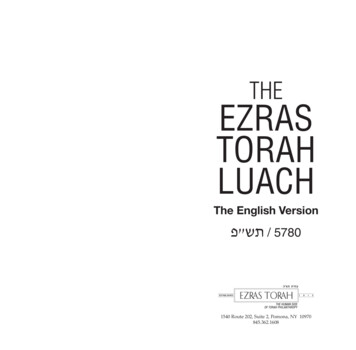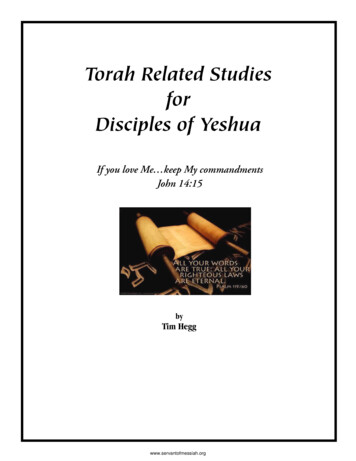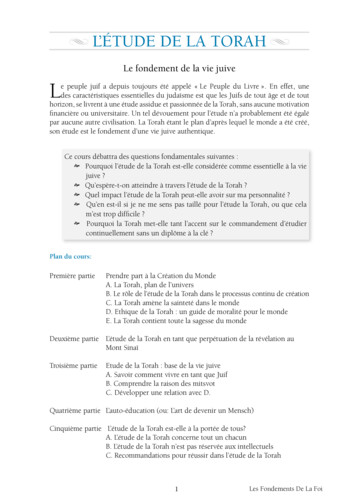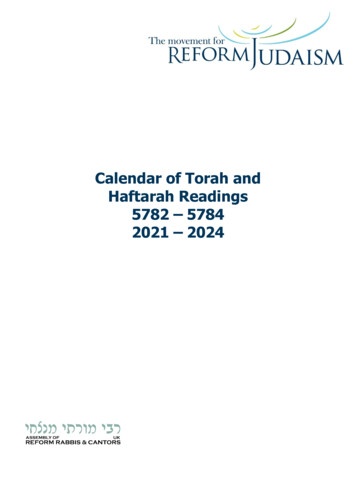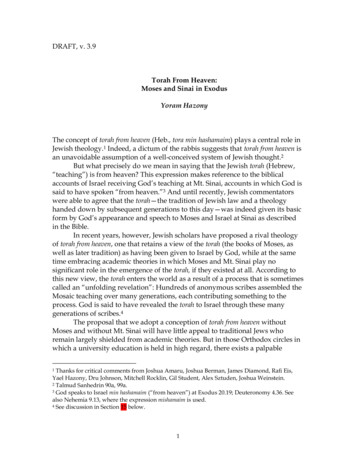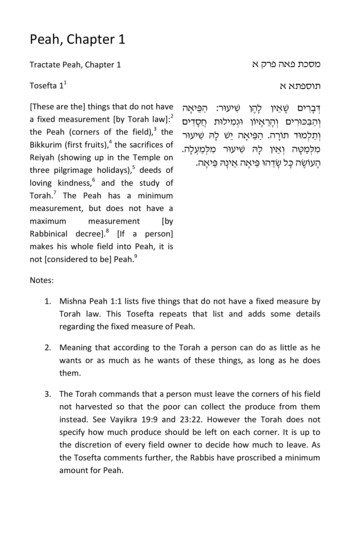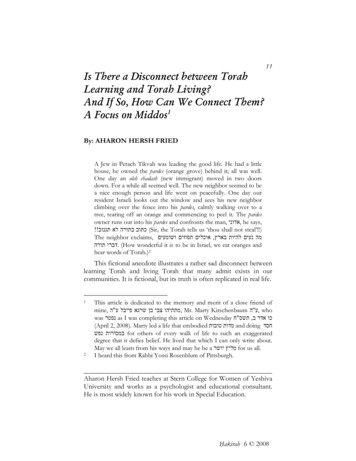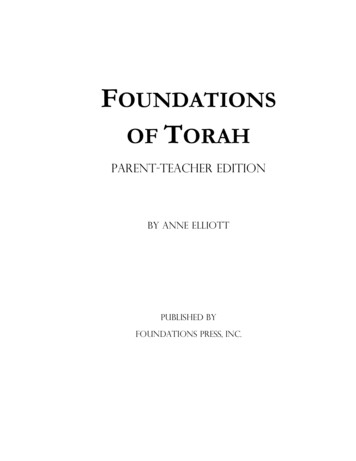
Transcription
FOUNDATIONSOF TORAHParent-Teacher EditionBy Anne ElliottPublished byFoundations Press, Inc.
FOUNDATIONS OF TORAHPARENT-TEACHER EDITIONCOPYRIGHT 2019 BY ANNE ELLIOTTALL RIGHTS RESERVEDNo part of this book may be used or reproduced in any manner whatsoever without written permission, exceptin the case of brief quotations embodied in critical articles or reviews.You do have permission to copy pages from the appendices for your own family’s personal use only.Redistributing copies to other families is strictly prohibited. Copies may not be made for classroom use withoutthe express written permission of the publisher. Additional copies of this book may be purchased atwww.foundationspress.comVisit us on Facebook ure taken from the English Standard Version (ESV) is adapted from the Revised Standard Version of theBible, copyright division of Christian Education of the National Council of theChurches of Christ in the U.S.A. All rights reserved.Scripture taken from the King James Version (KJV) is in the Public Domain.Scripture taken from the New King James Version (NKJV) is copyright 1982 by Thomas Nelson.Used by permission. All rights reserved.Scripture taken from the New International Version (NIV ) is copyright 1973, 1978, 1984, 2011by Biblica, Inc. Used by permission. All rights reserved worldwide.The World English Bible (WEB) is in the Public Domain.Unless otherwise noted, images obtained from the public domain,https://commons.wikimedia.orgPUBLISHED BYFOUNDATIONS PRESS, INC.P.O. BOX 191PERRY, MI 48872http://foundationspress.comAll links referenced in this book worked accurately when checked before publication.Please notify us if any link does not work so that we may update it in future editions.
You must continue in the things which you have learned and been assured of,knowing from whom you have learned them, and that from childhood you haveknown the Holy Scriptures, which are able to make you wise for salvationthrough faith which is in Messiah Yeshua.All Scripture is given by inspiration of God, and is profitable for doctrine, forreproof, for correction, for instruction in righteousness, that the man of God maybe complete, thoroughly equipped for every good work.2 Timothy 3:14-17
What Are Torah Portions?What is a “Torah Portion”? As one Sabbath-keeping organization explains,When God brought restoration and returned the Israelites from captivity [in Babylon], Ezraand Nehemiah and the men of their generation set to work creating a system to encourageTorah study. They wanted to ensure that the people would not slip into idolatry again. Theycreated a system for the synagogue to ensure that the people heard the Torah read every week.To this day, the Jewish world studies a portion of the Torah every Sabbath. Jews read theTorah aloud in synagogues on Sabbaths, Mondays and Thursdays. Monday and Thursday werethe ancient market days when rural people came into town. At this time, they also had theopportunity to hear the Word of God. On Sabbath days, the people assembled according tothe commandment.Since the days of the Apostles, the Torah continues to be read every week in the same manner.An annual lectionary, the Torah reading cycle, allows all Israel to study the same passages ofScripture simultaneously as they work through the Torah from week to week. The lectionarydivides the Torah into 2-6 chapter readings for each week. Corresponding readings from theProphets are tacked onto the weekly Torah readings. The reading cycle begins in the fall, afterthe Feast of Tabernacles, with Genesis 1:1. Approximately twelve months later, it concludeswith the last verses of the book of Deuteronomy.Reading along with the weekly Torah readings is a great way to study through the Torah everyyear. When you do, you are studying in synchronization with all Israel. Synagogues, study halls,and Messianic congregations all over the world will be examining the same passages ofScripture along with you.In each of the weekly readings, the portions (Hebrew: parashot) are named after thefirst word or distinctive phrase in the passage. In the days of the Apostles, the Bible wasnot divided into chapters and verses. People indicated different scripture passages by referringto the first Hebrew word or phrase of the passage. If a rabbi said, “In the place where it says,‘After the death of Aaron’s two sons '” he would be referring to parashat Acharei Mot,Leviticus 16:1-18:30. Acharei Mot means “after the death of.” In the same way, each portion(parasha) of Torah is named after its opening words, and each book of the Torah is namedafter its opening parasha. 1On the last day of each week, our lesson plans reference a Haftarah portion. What is this?The most common explanation is that in 168 BCE, when the Jews were under the rule of theSeleucid king Antiochus IV Epiphanes (of Chanukah infamy), they were forbidden to read fromthe Torah. The decree, however, was limited to the Five Books of Moses, so the sages institutedthat a section of the Prophets be read instead, usually an idea that was related to the Torahreading that should have been read that week. This custom stuck even after it became safe toread from the Torah again. 2It sounds very complicated the first time we learn about it, because we are accustomed to English Biblesdivided into chapters and verses. We are accustomed to pastors who teach topical sermons and mlhttps://www.chabad.org/library/article ing-the-Haftorah.htm7
around the Bible, from Old Testament to New Testament, basing their sermons on whatever needs theyfeel their congregation has.The Torah and Haftarah Portions ensure that all believers will hear the entire Torah read each year.Most Messianic congregations (congregations who believe that Yeshua of Nazareth is the Messiah ofIsrael) will make a special effort to include the teachings of the Apostles (the New Testament) in theirreading and study schedule as well.“For Moses has had throughout many generations those who preach him in every city, beingread in the synagogues every Sabbath” (Acts 15:21).The Apostles were convinced that new Gentile believers would be attending synagogue each Sabbathday and would therefore hear the written Torah of Moses read and explained. They knew that all therest of God’s commands would be learned week by week, slowly, in a way that wouldn’t beoverwhelming.Reading the Torah is going “back to basics.” This is true discipleship! As we read, chapter by chapter,through the first five books of the Bible, we can very naturally ask questions and learn how to applythe commands of God to our lives. Ideally, we can learn in a group environment, new believers withmature “old folks” who have been walking this road for a while.If you’re new, there is nothing to worry about. Just by attending a congregation where the Torah isread each week, in a year you’ll know more than most people who have attended church for years.If you take the time to read through each Torah portion at home throughout the week before Sabbath,you’ll be extremely well taught.If you take the time to also read the “Writings and Prophets,” which is the rest of the Old Testament,you’ll become firmly grounded in Scripture and won’t be as easily deceived by false teaching.If you take the time to also read the Apostolic Scriptures, you’ll understand how to apply yourunderstanding of God’s Law to your need for a Savior, and you’ll be taught the most common thingsGentiles need to learn.The original discipleship method is easy and effective!“You must continue in the things which you have learned and been assured of, knowing fromwhom you have learned them, and that from childhood you have known the Holy Scriptures,which are able to make you wise for salvation through faith which is in Messiah Yeshua.“All Scripture is given by inspiration of God, and is profitable for doctrine [teaching], forreproof, for correction, for instruction in righteousness, that the man of God may becomplete, thoroughly equipped for every good work” (2 Timothy 3:14-17).8 FOUNDATIONS OF TORAH
Resources:You can learn more at http://www.torahcalendar.com/PARASHAH.asp.We use the schedule posted yearly at HomechoolingTorah. (Check out the sidebar menu, part of theway down the page, for this year’s schedule.) This schedule is based uponhttps://www.hebcal.com/sedrot/.If you have no local congregation and would like to download Torah-portion study guides to use inweekly study with your family or a few friends, we recommend http://restorationoftorah.org orhttp://www.hoshanarabbah.org.Double PortionsThere are more Torah portions that can be read in a single year, although some years on the biblicalcalendar are “leap years” with 13 months instead of the regular 12 months.The rabbis devised an intricate reading schedule that would allow synagogues all over the world to bereading the same portions near biblical feast days, even in leap years.If you see that this year’s schedule combines any of the portions, you may choose to two weeks ofour plans to help you get through the reading schedule in sync with your local congregation.For more information, visithttps://www.chabad.org/library/article Double-Torah-Portion.htm9
Overview of a Weekly Lesson:Each Torah portion’s lesson includes the following information for the parent-teacher:Lesson OverviewTeacher’s NotesThis page is helpful for the teacher’s notebook, to see the entire week’splan at a glance.Overview ChartMemory VerseBible DrillsPrayer Requests & Answers to PrayerTorah Discussion &ActivitiesThese pages include possible discussion questions, with possible answersand further discussion topics, as well as optional activities you may wish toinclude during the week.Please note that your answers may disagree with ours. This is okay!The answers are only intended to be discussion starters.Other Activities:Occasional Optional Internet Links for More ActivitiesInternet Links to Worksheets for Older Children, Young Adults (and evenParents!)11
Note on Sacred Names:We use the Hebrew letters throughout this book to refer to the Creator of the Universe, our HeavenlyFather. His name in Hebrew is spelled יְ ה ֗ ָוה . In your English Bible, His name is translated as “theLORD.” Common pronunciations are “Ye-ho-VAH” or “YAH-way.” Some earlier Englishtranslations of the Bible wrote His Name as Jehovah.We also refer to Jesus by His Hebrew name Yeshua (pronounced “ye-SHOO-ah”). You may wish toteach your children that His name in Hebrew means “ יְה ֗ ָוה saves” (Matthew 1:21).We often use the word Messiah in place of the word Christ. Both mean “anointed one” and refer to theprophesied King and redeemer of Israel.The Golden Rule of Interpretation:“When the plain sense of Scripture makes common sense, seek no other sense; therefore, take everyword at its primary, ordinary, usual, literal meaning unless the facts of the immediate context, studiedin the light of related passages and axiomatic and fundamental truths, indicate otherwise.”— D.L. Cooper13
How to Use This Curriculum:We’d like to show you what a typical study of the weekly Torah portion looks like in our home.1. First, if we haven’t already done so, we start our day with prayer.2. Now we work on learning the week’s memory verse. You can read some of our methodsbelow.3. Dad, Mom, or an older student, then reads the day’s Torah portion aloud. You may usethe Bible translation of your choice.4. Often we will suggest discussion questions and activities for you to do. Please feel freeto add to or subtract from our suggestions, depending on the needs and interests of yourfamily, always listening to the leading of the Spirit.5. Twice each week, we like to have a “Bible Drill.” This is a game in which children race eachother to find passages of Scripture in their own Bibles. We urge you to play this game oftenso your children will gain the essential skill of finding passages in God’s Word quickly! Youmight want to wait until your children are old enough to read fairly well on their own (typically2nd or 3rd grade). At this age, purchase a good-quality Bible for our children, one which liesflat when opened.How to Have a Bible Drill: Have each child raise his Bible in the air, totally extendinghis arm. (It’s only fair.) Have him hold his Bible by the backbinding, with no fingers poking into the pages to keep his placefor him. The teacher announces the reference to be found (forinstance, “Genesis 1:1”). The children then repeat the reference orally, so that theteacher is sure everyone knows where to go and is listening. The teacher shouts, “Go!” At this point, each child pulls his Bible down and beginssearching for the Scripture reference as quickly as possible. The first child to find the reference stands. He then reads itout loud.If one child always wins, simply because he is older, take heart! The lessexperienced children will quickly improve with frequent practice and agood dose of healthy competition. However, you can add parents to thegame in the evenings for extra spice!6. At the end of each week, our notes suggest that your children write in their journals. Ourchildren each have a spiral or 3-ring notebook that is their Bible Journal. Once a week, theyreview what they’ve learned that week by telling about it in their journal. Young ones mightdraw a picture and have Mom write about it below. They might copy their memory verse.Older ones might tell what they’ve learned in their private Bible reading or copywork time.15
This journal will not only provide a record of their education; it will also become a pricelesstreasure that helps to cement God’s truth in their hearts.If you prefer, you may purchase journals from Foundations Press, which have been preparedspecifically for various abilities from early reader to high school.7. Please be open to the Holy Spirit as you work through His Torah portions. Always beready to discuss important concepts with your children and answer their questions. If youcome up with additional learning ideas, record them so that you’ll remember them next timeyou cover this material. Ask יְה ֗ ָוה to make His Torah meaningful to each of your children.16 FOUNDATIONS OF TORAH
Extra Worksheets and Coloring Pages: ://hoshanarabbah.org/parshiot.html (see sections entitled “Torah Explorers”)http://www.restorationoftorah.org (see the menu tab entitled “The Weekly Torah Portions”)https://www.aish.com/sh/f/Coloring ture-corner/torah-portion-quizzesPhoto by Sara Torda on Unsplash.com17
Hints for Memorizing Scripture:Our tips for memorizing verses each day are based on the following principles: It’s easier to memorize a verse if you know what it means. That’s why we spend the firstday of each week talking about what the verse means. Your children will illustrate the versealso, so you’ll know from their pictures if they truly understand it.It’s easier to memorize a verse if the verse is meaningful to you. Your job as a parent isto help your children relate the verse to their own lives. What promise does it make, whatadvice should they follow, what sin will it help them overcome? Try to talk about the verse atother times during the day, too. Ask the Holy Spirit to apply it to all of your lives.It’s easier to memorize a verse if you use many of your senses to learn it. We use oureyes when we look at a verse visual, we use our arms and legs when we make up motions, weuse our ears when we hear each other saying it together, and occasionally a verse is just theright kind to taste or smell something.It’s easier to memorize a verse if you repeat it many, many times. That’s why you shouldmake it your goal to have everyone say the verse out loud at least five times each day. We’llhelp you come up with ways to keep it from being boring, but you can always try shouting,whispering, singing, standing, marching, lying down, writing, drawing, telling it to Dad, andcalling Grandma.It’s easier to memorize a verse if you say it with a “sing-songy” voice. Kids love this! Forinstance, try saying this verse, emphasizing the italicized words:Psalm One -nineteen ElevenThy word have I hid in my heart,That I might not sin against thee .Psalm One -nineteen ElevenEach day, recite the verse (including reference) as a group five times. As the week progresses, allowthe children to say it more and more without dependence on your voice, until they can say itindependently by the end of the week.If you’re learning an extended passage of Scripture over many weeks, try to say the entire passageyou’ve learned thus far at least once a day. For instance, if you’re learning Deuteronomy 6:4-9 butyou’re only on verse 7 this week, you would review verses 4-7 once a day.Before the week starts, take a moment to write the verse (using a Sharpie marker) on a spiral-boundset of 3 5 index cards. You will use this set of verses to review in coming weeks.As a general rule, we’ll stick to the following schedule:Day 1 – Discuss what a verse means and illustrate it. Give your children sheets of paper,and ask them to illustrate the verse. Later, you can use these drawings to review verses you’vealready memorized. (Insert these papers into plastic sheet protectors and place in a notebook.)Day 2 – Copy the verse. For young writers, give them the copywork sheet we have provided.Preschool children will not write the verse, but you may want to have them point to letters ornumbers in the verse. Older children may copy the verse directly from their Bible into anotebook.19
Day 3 – Make up motions. Obviously, some verses will be easier to come up with motionsfor than others, but you’ll be surprised how creative your kids can be! You’ll probably noticethat they will use motions when they say it the rest of the week as well. That’s fine. Note: Ifit seems impossible to come up with motions, try stomping your feet in rhythm, clapping, ormarching around the kitchen table as you say it – anything to get you up and moving!Day 4 – Today is a good day for contests, since by now your kids should havenearly memorized the verse. “Everyone with blue eyes, say the verse,” “Everyonewearing green, say the verse,” boys against girls, younger versus older, etc.Day 5 – Today, have each child say it individually. After saying the verse severaltimes as a group, I often start with the oldest child so that the youngest ones can hearit a few more times. I also “help” the younger ones more than I do the older ones,whom I expect to say it perfectly. You may wish to have a “verse recital” on ErevShabbat (Friday evening), where the kids can show Dad how well they’ve learned theirverse. You could also exhibit their drawings and writings. Make it memorable!All of the above hints are helpful for other types of memorization as well, such as the Booksof the Bible, or memory work in other subjects.20 FOUNDATIONS OF TORAH
B’reisheet אשית ִׁ “ ְּב ֵר In the Beginning”(Genesis 1:1 - 6:8)Prayer TimeMemory VerseRead and Discussthe ParashahBible DrillHomeworkDay 1 Discussmemory verse Genesis 1:12:3 Illustratememory verseDay 2Day 3 MotionsDay 4 ContestsDay 5 Test Genesis 2:43:24 Genesis 4 Genesis 5:16:8 Haftarah:Isaiah 42:5 43:10 Bible drill Copymemory verse Bible drill Otheractivities JournalsTeacher’s Notes:Memory Verse:Hebrews 11:3 (WEB) – “By faith, we understand that the universe has been framed by the word of God, so that whatis seen has not been made out of things which are visible.”Bible Drills:Tuesday – The Word is Psalm 119:105 Ephesians 5:26 John 1:14 Hebrews 4:12 James 1:25Thursday – The Word is John 15:3 Jeremiah 23:29 Ephesians 6:17 Jeremiah 20:9 Revelation 19:13Prayer Requests this Week:Answers to Prayer:B’reisheet (Genesis 1:1-6:8) 23
Dear Parent,Shavua tov! This week's Torah portion is called B'reisheet, which starts back at the book of Genesis.Many of us are starting this study during the days of the biblical fall feast of Sukkot (Feast of Trumpets) and still have afew days of feasting and fun ahead of us. I hope you have created special memories with your children. Remember thatthe feast days were instituted for the children, so that when they ask you "why" you're doing something, you can explainYHVH's wonderful plan to them. (See Exodus 12:6-7.)But soon you'll be home again, and we will have the privilege of starting back into our daily routines. The Torah portionsstart back at Genesis, and of course, math and grammar are happily waiting for you as well!Don't be surprised if you need a few days to "decompress" and figure out your routine again. You might even need tosleep in a few times! Try to eat a diet low in sugar, remember to remind your children of simple household rules again,and be filled with compassion as you settle into life.However, this is a FOUNDATIONAL section of the Torah, and even if your days are busy, we strongly recommendat least taking the time to read and discuss this passage in Genesis. We feel these are the most important chapters in theTorah, if not the entire Scriptures! AnneSchäk, Joseph. Drittes Lesebuch. New York: Fr. Pustet, 1874. "Butterfly."24 FOUNDATIONS OF TORAH
B’reisheet – Discussion & ActivitiesDay 1 – Genesis 1:1-2:3 According to Genesis 1:3, how did YHVH create the world?According to Genesis 1:3, YHVH created the world by His Word: “And God said.”Look up John 1:1-3, 9-10 and Hebrews 11:3. How did God create the world?In John 1:1-3, we learn that God created the world by the Word. In John 1:9-10, we learn that the“Light” made the world. This Light is Yeshua, according to John 1:14.In Hebrews 11:3, we learn that the worlds were “framed,” or created, by the word of God. Discuss some ways that we are made in the image of God. (See Genesis 1:27.)To be made in the image of God means that we can make things like He can (although we can’tcreate out of nothing or with His power and might). We are “creative” like He is!You may also wish to read Genesis 5:2, Psalm 8:1-9, and 1 Corinthians 11:7.We are made as “male and female” (Genesis 5:2) and able to reproduce children, and we havedominion over His creation (Psalm 8). Genesis 1:27 and 1 Corinthians 11:7 both seem to say thatman was made in God’s image but that the woman was made in the image of man, just as childrenare made in the image of their parents. We look just like them! Using a Strong’s concordance, look up the words “ended” and “rested” in Genesis 2:2. Whatdo these words mean in Hebrew? Why did God cease from His labor?(Note: We will frequently use a Strong’s concordance in this curriculum. You may wish to usehttp://blueletterbible.org online.)ended - Strong's H3615, kalah: to accomplish, to end, to complete.rested - Strong's H7673, shabath: to cease, to repose (rest). Sing the fun Creation song at the end of this week’s lesson.Day 2 – Genesis 2:4-3:24 Look up the Hebrew meaning of the name “Adam.” (See Genesis 2:19-20.)Adam - Strong's H120, adam: ruddy (red), from the ground. Look up the Hebrew meaning of the name “Eve.” (See Genesis 3:20.)Eve - Strong's #2332, chavah: life-giver. According to Genesis 1:26-30 and Genesis 2:15, what was man’s job? According to Genesis1:28, God told man to be fruitful and multiply (have children) and to fill the earth. Man was also tosubdue the earth and have dominion over the fish, the birds, and every living thing. According toGenesis 2:15, man was put into the garden to dress it (work in it to make it beautiful) and keep(guard) it. One way the serpent tempted Eve was to cause her to doubt what God really said. (SeeGenesis 3:1.) Look up three kinds of temptation listed in 1 John 2:16.1 John 2:16 lists these three temptations: (1) the lust of the flesh, (2) the lust of the eyes, and (3) thepride of life.How did Yeshua defeat temptation in Matthew 4:4, 7, and 10?In Matthew 4:4, 7, and 10, Yeshua defeated temptation by quoting Scripture (“it is written”).You might also wish to read Ephesians 6:10-18.Ephesians 6:10-18 tells us to put on the whole armor of God, and one of those pieces is the “swordof the Sprit, which is the word of God” (verse 17).B’reisheet (Genesis 1:1-6:8) 25
Day 3 – Genesis 4 Why do you think YHVH would not accept Cain’s sacrifice? Read Hebrews 11:4.oAccording to Hebrews 11:4, Abel offered a more excellent sacrifice, which showed he wasrighteous. We can only assume that Abel followed YHVH’s instructions, where Cain did not. Name some inventions and first things that are listed in Genesis 4. For instance, the first city(verse 17), the first music (verse 21), etc.Genesis 4:1 – first shepherdGenesis 4:1 – first farmerGenesis 4:17 – first city builderGenesis 4:20 – first tent dwellerGenesis 4:20 – first cattle farmerGenesis 4:21 – first maker of musical instrumentsGenesis 4:22 – first forger of brass and iron Read Genesis 4:26. What do you think it means to “call upon the name of YHVH”?It is often a reference to worshiping YHVH with sacrifices and to worship Him alone, as comparedto worshiping other gods. Compare to 1 Kings 18:24; Psalm 116:17; Joel 2:32, and Zephaniah 3:9.Day 4 – Genesis 5:1-6:8 Look up the meanings of the names listed in chapter 5. What do these tell you about whatthe world was like at this time?Adam - Strong's H120, ruddy (red), from the ground.Seth - Strong's H8352, appointed, substitution.Enos - Strong's H583, mortal, man, son of man.Cainan - Strong's H7018, possession, dwelling place.Mahalale’el - Strong's H4111, praise of God.Jared - Strong's H3382, descent.Enoch - Strong's H2585, dedicated, teacher.Methuselah - Strong's H4968, man of a dart, or “his death shall bring.”Lamech - Strong's H3929, powerful, despairing.Noah - Strong's H5146, rest, comfort.Shem - Strong's H8035, name.Ham - Strong's H2526, hot.Japheth - Strong's H3315, opened.(See also Genesis: Finding Our Roots, by Ruth Beechick, pp. 49-51.) What does it mean to “walk with God”? (See Genesis 5:24. Compare to Genesis 6:9 andGenesis 17:1.) If we compare Genesis 5:24 to Genesis 6:9 and Genesis 17:1, we see that those who“walk with God” are described as perfect. The word perfect means whole-hearted. You might want tolook up Amos 3:3. What does it mean that Noah “found grace in the eyes of YHVH”? (See Genesis 6:8.) You mightwant to look up the Hebrew word translated as “grace” (Strong's H2580, favor, acceptance).Read Hebrews 11:6-7. In Hebrews 11:6-7, we read that Noah had faith and that he believed Godenough to be moved with fear and prepare an ark to save his family.26 FOUNDATIONS OF TORAH
Day 5 – Isaiah 42:5-43:10 The “Haftarah” was compiled during the time of the Maccabees, when the Greekgovernment over Judah would not allow the Jews to read from the Torah. Righteous mencompiled a haftarah schedule of passages outside the Torah that would help them rememberwhat each Torah portion was about. Can you find the similarities between this week’s Torahand Haftarah portions?In this Haftarah portion, we see many ways that YHVH is powerful enough to create our world andalso to restore the world that has been damaged by sin. There are many things listed which only Godcan do! We also see His preservation of His people during times of judgment. Do you see any otherthings? As you read today, name some specific things which YHVH created.oSee the following verses:Isaiah 42:5Isaiah 42:15Isaiah 43:1Isaiah 43:7B’reisheet (Genesis 1:1-6:8) 27
“On Day One”by Melody Waring (to the tune of “This Old Man”)On day one,Yah made light,He made day and He made night.With a knick-knack paddy-whack only Yah aloneCould make me such a perfect home.On day two,Yah made Heaven,Made it as a place for livin’.With a knick-knack paddy-whack only Yah aloneCould make me such a perfect home.On day three,Yah made earthWith some trees and plants and herbs.With a knick-knack paddy-whack only Yah aloneCould make me such a perfect home.On day four,He made the sun,Stars and moon for sparkly fun.With a knick-knack paddy-whack only Yah aloneCould make me such a perfect home.On day five,Yah made fish,Birds and whales with tails that swish.With a knick-knack paddy-whack only Yah aloneCould make me such a perfect home.On day six,Yah made critters,You and me and things that jitters,With a knick-knack paddy-whack only Yah aloneCould make me such a perfect home.On day seven,Yah said, “Rest‘Cause I love you, and it’s best!”With a knick-knack paddy-whack only Yah aloneCould make me such a perfect home.Some peopleSeem to thinkYah did not make everything, butWith a knick-knack paddy-whack only Yah aloneCould make me such a perfect home.11Source: ginning-2/28 FOUNDATIONS OF TORAH
Noach ַ " נֹ ח Noah"(Genesis 6:9 – 11:32)Prayer TimeMemory VerseRead and Discussthe ParashahBible DrillHomeworkDay 1 Discussmemory verse Genesis 6:98:22 Illustratememory verse Day 2Day 3 MotionsDay 4 ContestsDay 5 Test Genesis 9 Genesis 10 Genesis 11 Haftarah:Isaiah 66:1-242 Bible drill Copymemory verse Bible drill Otheractivities JournalsTeacher’s Notes:Memory Verse:Isaiah 49:6 (WEB) – “Indeed, he says, ‘It is too light a thing that you should be my servant to raise up the tribesof Jacob, and to restore the preserved of Israel? I will also give you as a light to the nations, that you may bemy salvation to the end of the earth.’”3Bible Drills:Tuesday – “wine” Genesis 14:8 Psalm 4:7 Proverbs 31:4 Joel 2:19 Luke 1:15Thursday – Strong’s #2865, chathath Deuteronomy 1:21 Joshua 8:1 Job 7:14 2 Chronicles 32:7 Jeremiah 51:56Prayer Requests this Week:Answers to Prayer:Some congregations read Isaiah 54:1-55:5 this week, as well as in the KiTetzei portion later this year. We have chosen to substitute Isaiah 66:1
Torah study. They wanted to ensure that the people would not slip into idolatry again. They created a system for the synagogue to ensure that the people heard the Torah read every week. To this day, the Jewish world studies a portion of the Torah every Sabbath. Jews read the Torah aloud in synagogues on Sabbaths, Mondays and Thursdays.

